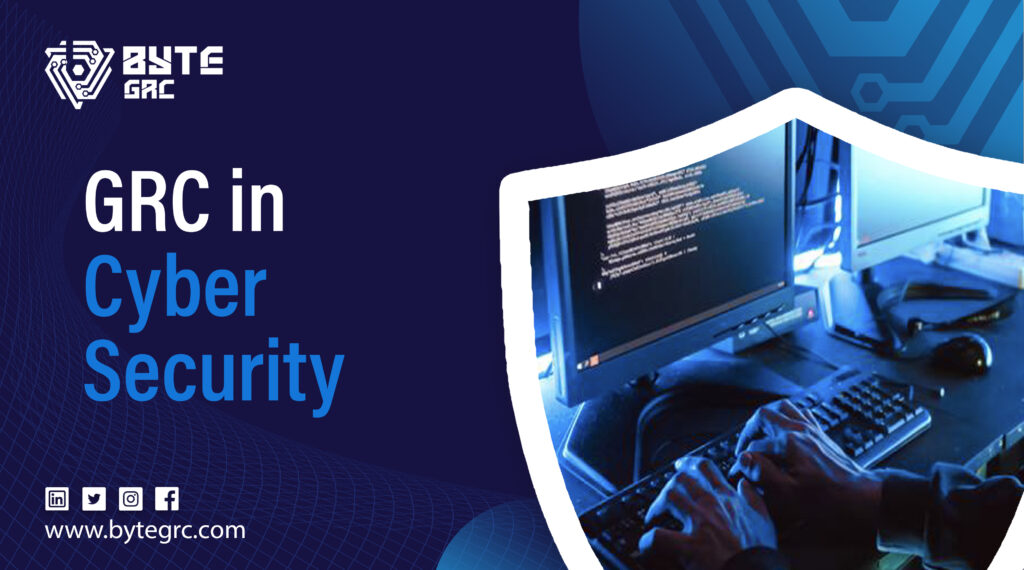|
Getting your Trinity Audio player ready...
|

Table of Contents
What Is Governance, Risk, And Compliance - GRC In Cyber Security?
When the word cyber security comes, the first things that comes into mind are firewalls, system protection, red-team, blue-team, data breaches, and more things like that. But one important thing that is crucial but overlooked is the term GRC aka Governance, Risk Management, Compliance. For companies that handle, sensitive data, important documents GRC isn’t something they should be avoiding. It’s mandatory!
ByteGRC’s sole purpose is to guide and help modern organizations integrate GRC in their companies to control risks, and maintain regulatory. But before we talk further about ByteGRC, let’s see why GRC in cyber security so important.
What Is GRC?
GRC stands for Governance, Risk Management, and Compliance. It’s a complete framework that helps businesses make sure that all operations are aligned with goals, manage risks properly, and follow all protocols the way they should be followed.
Think of GRC, as a three-legged table, even if one of the legs got weakened the whole structure will become weak and eventually fall to its demise, and we seriously don’t want that to happen now, do we? GRC in cybersecurity ensures that your organization is resilient and accountable.
Each part of GRC serves a unique role:
- Governance: Ensuring that corporate strategies align with cybersecurity decisions
- Risk Management: Identifying, analyzing, and mitigating potential security threats
- Compliance: Making sure the organization meets legal, regulatory, and policy requirements
What Is Governance?
Governance is the strategic oversight and direction given by leadership. In cybersecurity, it involves making sure that the right cybersecurity policies, processes, and controls are in place and being followed throughout the organization.
Key elements of governance in cybersecurity include:
- Clear security leadership and roles (e.g., CISO, GRC Officer)
- Cybersecurity policies and frameworks (e.g., NIST, ISO 27001)
- Alignment between business strategy and security goals
What Is Risk Management?
As the name implies risk management, it’s about recognizing threats, evaluating how likely things are to happen, and tells how you can handle them. It’s a cycle of constant monitoring, analyzing, and making room for never ending improvement.
By risks we mean, phishing attacks, insider threats or even the instability of your organization. Risk management helps identify weakness, so you can address them first and improve you’re the growth of your company.
Steps in risk management include:
- Risk identification: e.g., unprotected endpoints, third-party vendor access
- Risk assessment: how severe and likely is the risk?
- Risk mitigation: implementing technical or procedural controls
- Monitoring: tracking known risks and identifying new ones
What Is Compliance?
Compliance is the part that makes sure your organization is following the standard protocols, all the legal requirements, and internal policies.
Compliance in cyber security means aligning your outlines like this:
- GDPR (General Data Protection Regulation)
- HIPAA (Health Insurance Portability and Accountability Act)
- PCI DSS (Payment Card Industry Data Security Standard)
- SOX (Sarbanes-Oxley Act)
Why Is Governance, Risk, And Compliance Important?
Cybersecurity has evolved a lot in the past years. You’re no longer just protecting your network or your system; you’re guarding your organization.
Why GRC is Important
- Regulatory Landscape Is Expanding: With more data privacy laws and industry-specific mandates, staying compliant is a moving target.
- Cyber Threats Are Rising: From ransomware to nation-state attacks, the threat surface is expanding.
- Operational Complexity: Remote work, cloud infrastructure, third-party vendors it’s hard to secure what you can’t see.
- Reputation Is On The Line: One breach can tarnish years of trust.
What Are The Challenges of GRC?
While GRC sounds like a silver bullet, it comes with its own set of hurdles especially for growing businesses.
1. Siloed Teams and Data
Often, governance, risk, and compliance efforts are handled by different departments. This creates data silos and communication gaps.
2. Manual Processes
Spreadsheets and emails can only take you so far. Without automation, GRC becomes time-consuming and error-prone.
3. Changing Regulations
Regulatory requirements evolve fast. Staying up to date across different regions and industries can be overwhelming.
4. Lack of Visibility
Without real-time dashboards and alerts, it’s hard to understand your organization’s actual risk posture.
5. Resource Constraints
Small and mid-sized businesses might lack the budget or personnel to run a full-fledged GRC program.

What Is The Role Of Technology In GRC?
Technology is the enabler that transforms GRC from a checklist to a real-time, strategic capability. Without software platforms, it’s nearly impossible to manage GRC effectively across growing digital environments.
How platforms like ByteGRC support GRC
- Automation: Automation helps reduce human errors, and make your work run faster.
- Dashboards: You can check risk levels and make sure your policies are enforced the right way.
- Policy Enforcement: Ensure all endpoints met and the users follow consistent controls.
- Audit Ready: Always have your logs and documents ready for audits.
How Can Organizations Implement GRC in Cybersecurity?
Whether you’re a startup or a small company, the principles always remain the same.
Step-by-Step Approach
- Assess Your Current State
Understand your organization’s maturity level across governance, risk, and compliance. - Define Roles and Responsibilities
Assign ownership: CIOs, CISOs, risk managers, and compliance officers must collaborate. - Choose a GRC Framework
Common options include NIST Cybersecurity Framework, ISO 27001, or COBIT depending on your industry. - Centralize and Automate
Implement a platform like ByteGRC to centralize your controls, workflows, and reporting. - Train Teams
GRC isn’t just for leadership train all employees on security best practices and policy requirements. - Monitor and Improve
Use real-time analytics, incident tracking, and audit logs to continuously refine your GRC posture.
By streamlining these processes with the help of ByteGRC, you not only reduce security incidents you also turn compliance into a competitive advantage.
Bottom Line
Today, you just can’t afford to separate cyber security from GRC. GRC in cyber security isn’t some sort of luxury, it’s a necessity. And yeah, we know managing all this GRC stuff might sound complex and trust me, it is that is if it’s not managed properly.
But nothing can be complex if you have ByteGRC on your side that can make you prepare for audits, or can simply protect your organization for severe threats.
FAQ
1: What does GRC stand for in cybersecurity?
GRC stands for Governance, Risk Management, and Compliance. It helps businesses align cybersecurity with strategic goals while managing threats and regulatory requirements.
2: Why is GRC important for cybersecurity?
GRC ensures that security decisions are aligned with business objectives, helps mitigate risk, and ensures compliance with laws and standards.
3: What industries require GRC practices?
Financial services, healthcare, e-commerce, government, and cloud-based SaaS businesses all require strong GRC frameworks.
4: How is ByteGRC different from traditional GRC tools?
ByteGRC provides real-time visibility, automates tedious compliance tasks, and integrates with your existing security tools making GRC fast, actionable, and accessible.
5: Is GRC only for large enterprises?
No. Even small and medium businesses need GRC, especially as regulatory scrutiny increases and threats become more sophisticated.
6: What are examples of GRC frameworks?
NIST, ISO 27001, COBIT, and CIS Controls are popular frameworks that guide organizations in establishing GRC policies.
7: Can GRC reduce cyber insurance premiums?
Yes. A well-documented and functioning GRC program can demonstrate reduced risk, which may lower your cybersecurity insurance premiums.
8: How do I know if my business is compliant?
Platforms like ByteGRC offer compliance dashboards and audit logs to track your organization’s adherence to key regulations.
9: How often should risk assessments be done?
At minimum annually, but ideally quarterly or in real time using automated risk monitoring tools.
10: What happens if I ignore GRC?
Ignoring GRC can lead to data breaches, non-compliance penalties, lost customer trust, and legal consequences.

